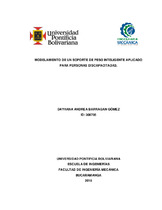| dc.contributor.advisor | Director. Córdoba Tuta, Edwin Jesús | |
| dc.contributor.author | Barragán Gómez, Dayhana Andrea | |
| dc.coverage.temporal | 2018 | |
| dc.date.accessioned | 2020-07-08T16:19:34Z | |
| dc.date.available | 2020-07-08T16:19:34Z | |
| dc.date.issued | 2018 | |
| dc.identifier.uri | http://hdl.handle.net/20.500.11912/5692 | |
| dc.description | 76p.: (pdf); il; Imágenes; tablas; anexos. | spa |
| dc.description.abstract | El uso del soporte de peso corporal (SPC) posibilita la rehabilitación de la marcha de individuos por medio de la ayuda parcial de su peso sobre los miembros inferiores. Hay varias causas para la anormalidad en la marcha. En la mayoría de los sobrevivientes se observan deficiencias neurológicas significativas, lo que hace que el porcentaje de muertes por accidente vascular encefálico (AVE) sea aproximadamente del 40% al 50%, en un período de seis meses. La AVE es la primera causa de incapacidad funcional observada en el mundo. Estas deficiencias hacen al individuo incapaz de tener un comportamiento motor normal debido al daño en el sistema nervioso central, que altera la capacidad integrativa del cerebro. Ante estos datos, el objetivo de este proyecto de investigación es desarrollar el modelado de un sistema de elevación a ser acoplado en cualquier estera aplicada para desarrollar marcha en individuos con restricciones. Para ello, se utilizó la matriz del desdoblamiento de la función de calidad (QFD), con el fin de transcribir en el modelo los requisitos de cliente y transformarlo en descripción y el TopSolid® para el diseño paramétrico. Se tiene como resultado el desarrollo del sistema completo, automatizado con servo motor, célula de carga y sistemas mecánicos con foco en el bajo costo. El modelo desarrollado en este proyecto de investigación generó un avance en innovación tecnológica y accesibilidad a la población. | spa |
| dc.description.abstract | The use of body weight support (SPC) makes it possible to rehabilitate the gait of individuals through the partial help of their weight on the lower limbs. There are several causes for gait abnormality. In the majority of the survivors significant neurological deficiencies are observed, what causes that the percentage of deaths by cerebral vascular accident (AVE) is approximately of 40% to 50%, in a period of six months. The AVE is the first cause of functional disability observed in the world. These deficiencies make the individual unable to have normal motor behavior due to damage to the central nervous system, which alters the integrative capacity of the brain. Given these data, the objective of this research project is to develop the modeling of a lifting system to be coupled in any applied mat to develop gait in individuals with restrictions. For this, the matrix of the splitting of the quality function (QFD) was used, in order to transcribe in the model the customer requirements and transform it into a description and the TopSolid® for the parametric design. The result is the development of the complete system, automated with servomotor, load cell and mechanical systems with focus on low cost. The model developed in this research project generated an advance in technological innovation and accessibility to the population. | eng |
| dc.format.mimetype | application/pdf | |
| dc.language.iso | spa | |
| dc.publisher | Universidad Pontificia Bolivariana | spa |
| dc.rights | Attribution-NonCommercial-NoDerivatives 4.0 International | * |
| dc.rights.uri | http://creativecommons.org/licenses/by-nc-nd/4.0/ | * |
| dc.title | Modelamiento de un soporte de peso inteligente aplicado para personas discapacitadas | spa |
| dc.type | Trabajo de grado | spa |
| dc.publisher.department | Escuela de Ingenierías | spa |
| dc.publisher.program | Ingeniería Mecánica | spa |
| dc.type.hasVersion | publishedVersion | spa |
| dc.description.sectional | Bucaramanga | spa |
| dc.description.degreename | Ingeniero Mecánico | spa |


